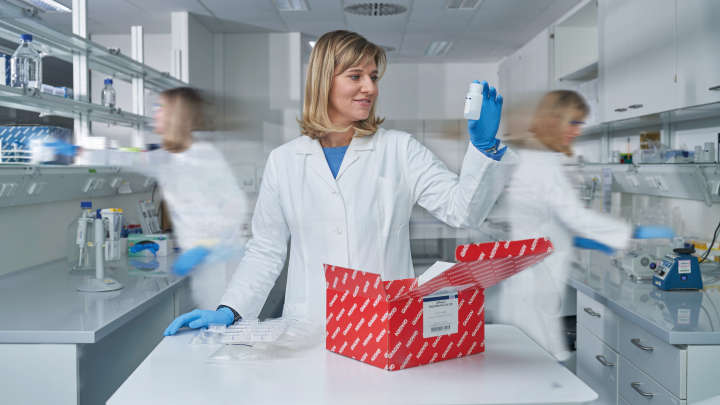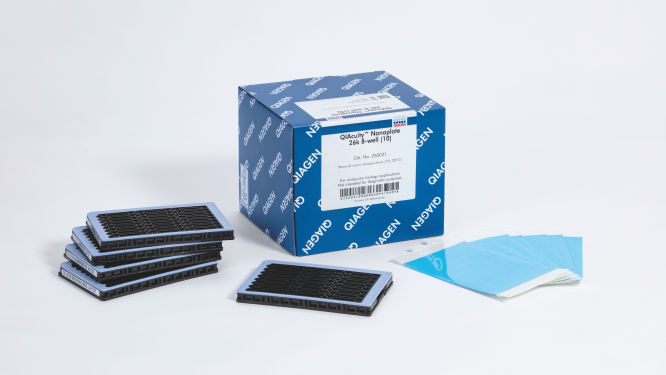✓ Traitement automatique des commandes en ligne 24 h/24 7 j/7
✓ Assistance technique et produits pertinente et professionnelle
✓ Commande (ou réapprovisionnement) rapide et fiable
QIAcuity Nanoplate 26k 8-well (10)
N° de réf. / ID. 250031
✓ Traitement automatique des commandes en ligne 24 h/24 7 j/7
✓ Assistance technique et produits pertinente et professionnelle
✓ Commande (ou réapprovisionnement) rapide et fiable
Caractéristiques
- Quatre nanoplaques pour différents besoins applicatifs
- Jusqu’à 8 500 ou 26 000 partitions par puits
- Format SBS
Détails produit
Les QIAcuity Nanoplates sont des plaques de PCR numérique microfluidiques qui permettent d’analyser 8, 24 ou 96 échantillons avec jusqu’à 8 500 ou 26 000 partitions par puits. Les quatre nanoplaques sont conçues pour fonctionner sur les instruments de PCR numérique QIAcuity.
Ces nanoplaques ne peuvent être utilisées qu’avec le QIAcuity Digital PCR System. Utilisez le QIAcuity Nanoplate Adapter pour la manipulation de liquides et la configuration de la PCR automatisées dans une QIAcuity Nanoplate sur le QIAgility. Ensuite, chargez la plaque dans le QIAcuity Digital PCR System pour la réaction de dPCR.
Souhaitez-vous en savoir plus sur ce produit et être contacté par l’un de nos spécialistes de la dPCR ? Inscrivez-vous ici, et nous vous contacterons très prochainement.
Performances
Il s’agit de plaques spécialement conçues pour les réactions de PCR numérique dans les instruments QIAcuity. QIAGEN propose quatre types de nanoplaques qui sont toutes au format SBS, mais présentent différentes spécifications pour différents besoins applicatifs.
| Type | Couleur du cadre | Spécifications | Applications |
| Nanoplate 26K 8-well | Bleu clair |
8 puits × env. 26 000 partitions Réaction de dPCR de 40 µl par puits |
Détection des mutations rares, biopsie liquide, analyse de l’expression génique, détection des agents pathogènes, etc. |
| Nanoplate 26K 24-well | Bleu |
24 puits × env. 26 000 partitions Réaction de dPCR de 40 µl par puits |
Détection des mutations rares, biopsie liquide, analyse de l’expression génique, détection des agents pathogènes, etc. |
| Nanoplate 8,5K 24-well | Blanc |
24 puits × env. 8500 partitions Réaction de dPCR de 12 µl par puits |
Analyse des variations du nombre de copies, analyse de l’expression génique, quantification de banques NGS, détection des modifications du génome, etc. |
| Nanoplate 8,5K 96-well | Gris |
96 puits × env. 8500 partitions Réaction de dPCR de 12 µl par puits |
Principe
Vous pouvez obtenir, en seulement 3 étapes simples, le résultat de dPCR que vous voulez en moins de 2 heures : pipettez et chargez, effectuez l’expérience, puis analysez les résultats. Vous trouverez ici une description du principe de la réaction de dPCR sur nanoplaque.
Procédure
Comme dans les expériences de qPCR, la préparation des échantillons comprend le transfert du Master Mix, des sondes et des amorces sur une nanoplaque de 8, 24 ou 96 puits, suivi de l’ajout des échantillons. Le système intègre le partitionnement, le thermocyclage et l’imagerie dans un seul instrument entièrement automatisé qui permet aux utilisateurs de passer de l’échantillon aux résultats en moins de 2 heures. Il est possible d’effectuer l’analyse à l’aide de la suite logicielle, qui donne la concentration de la séquence cible en copies par microlitre et permet le contrôle qualité pour les échantillons positifs ou NTC. Cette analyse peut également être effectuée sur des ordinateurs à distance au sein du même réseau local (Local Area Network, LAN).
Applications
Associées avec le QIAcuity Digital PCR System et les kits de PCR QIAcuity, les QIAcuity Nanoplates facilitent les applications de PCR numérique telles que :
- La détection des mutations rares
- L’analyse des variations du nombre de copies
- L’analyse de l’expression génique
- La détection des agents pathogènes
- Le génotypage
- La recherche sur les miARN
- La thérapie génique et cellulaire
- La quantification de l’ADN résiduel
- La surveillance des eaux usées

